Conspicuous Consumption Questionnaire Report for Consumer Affairs
VerifiedAdded on 2021/06/16
|10
|1546
|21
Report
AI Summary
This report presents the findings of a questionnaire survey conducted by Victoria University students on behalf of the Department of Consumer Affairs. The study investigates the social demographic factors influencing conspicuous consumption among tourists. The questionnaire, administered to a group of fifty tourists, explores various factors such as income levels, education, place of residence, and personal traits to understand their impact on spending habits. The report includes an analysis of the survey methodology, which involved a standardized questionnaire with open-ended and closed-ended questions, and an examination of the relationships between different variables. The objective is to address management problems associated with conspicuous consumption by understanding the underlying consumer behavior. The report also provides a detailed literature review and references supporting the research.
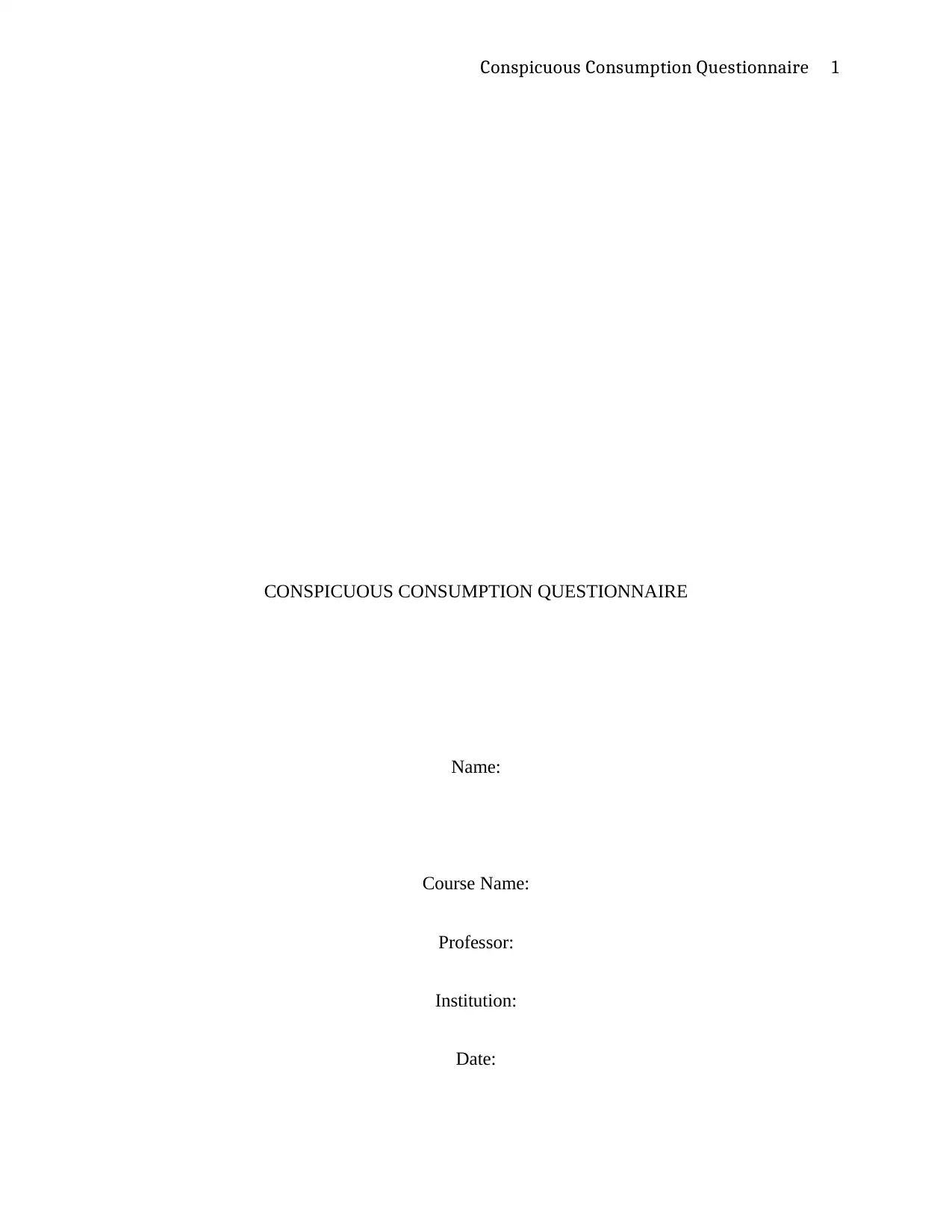
Conspicuous Consumption Questionnaire 1
CONSPICUOUS CONSUMPTION QUESTIONNAIRE
Name:
Course Name:
Professor:
Institution:
Date:
CONSPICUOUS CONSUMPTION QUESTIONNAIRE
Name:
Course Name:
Professor:
Institution:
Date:
Paraphrase This Document
Need a fresh take? Get an instant paraphrase of this document with our AI Paraphraser
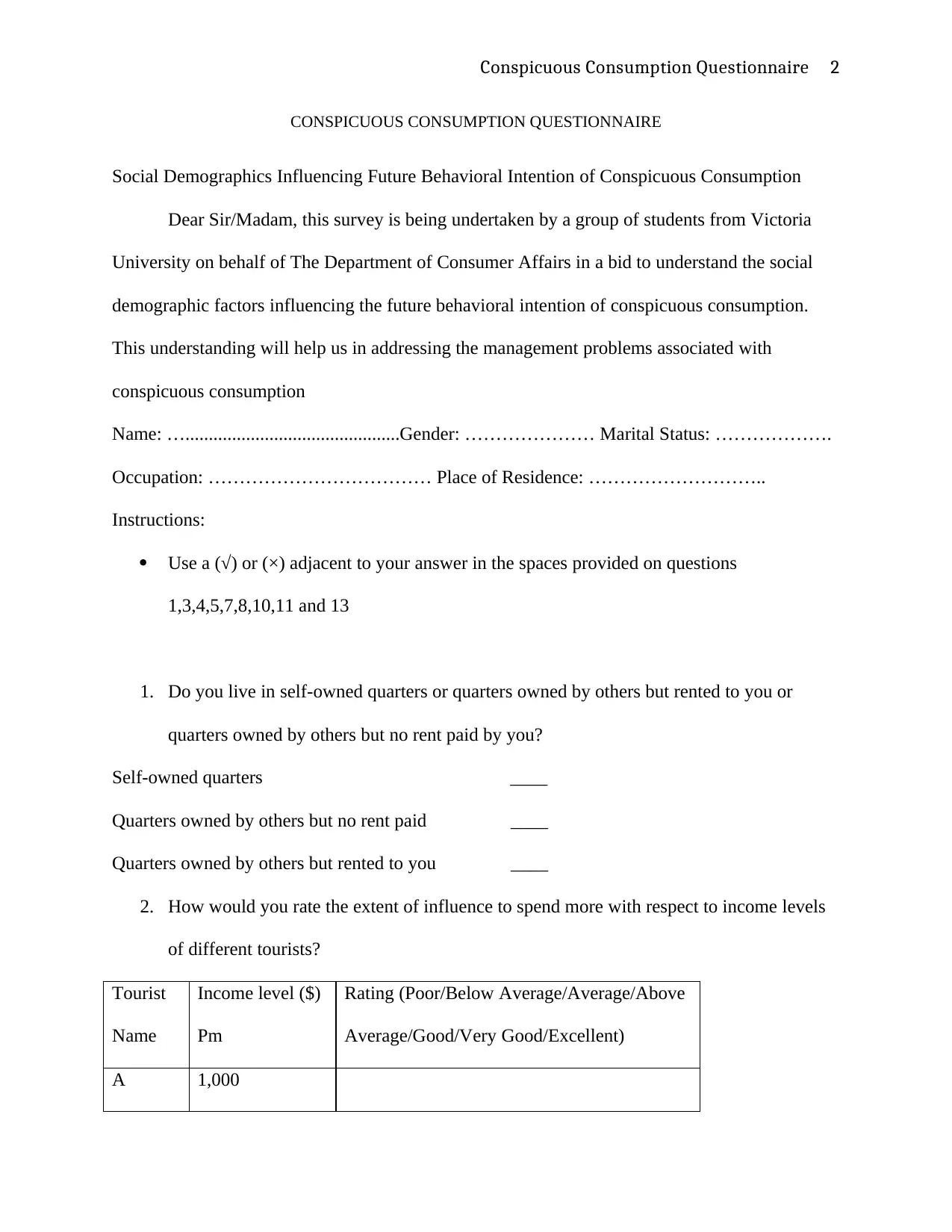
Conspicuous Consumption Questionnaire 2
CONSPICUOUS CONSUMPTION QUESTIONNAIRE
Social Demographics Influencing Future Behavioral Intention of Conspicuous Consumption
Dear Sir/Madam, this survey is being undertaken by a group of students from Victoria
University on behalf of The Department of Consumer Affairs in a bid to understand the social
demographic factors influencing the future behavioral intention of conspicuous consumption.
This understanding will help us in addressing the management problems associated with
conspicuous consumption
Name: …..............................................Gender: ………………… Marital Status: ……………….
Occupation: ……………………………… Place of Residence: ………………………..
Instructions:
Use a (√) or (×) adjacent to your answer in the spaces provided on questions
1,3,4,5,7,8,10,11 and 13
1. Do you live in self-owned quarters or quarters owned by others but rented to you or
quarters owned by others but no rent paid by you?
Self-owned quarters ____
Quarters owned by others but no rent paid ____
Quarters owned by others but rented to you ____
2. How would you rate the extent of influence to spend more with respect to income levels
of different tourists?
Tourist
Name
Income level ($)
Pm
Rating (Poor/Below Average/Average/Above
Average/Good/Very Good/Excellent)
A 1,000
CONSPICUOUS CONSUMPTION QUESTIONNAIRE
Social Demographics Influencing Future Behavioral Intention of Conspicuous Consumption
Dear Sir/Madam, this survey is being undertaken by a group of students from Victoria
University on behalf of The Department of Consumer Affairs in a bid to understand the social
demographic factors influencing the future behavioral intention of conspicuous consumption.
This understanding will help us in addressing the management problems associated with
conspicuous consumption
Name: …..............................................Gender: ………………… Marital Status: ……………….
Occupation: ……………………………… Place of Residence: ………………………..
Instructions:
Use a (√) or (×) adjacent to your answer in the spaces provided on questions
1,3,4,5,7,8,10,11 and 13
1. Do you live in self-owned quarters or quarters owned by others but rented to you or
quarters owned by others but no rent paid by you?
Self-owned quarters ____
Quarters owned by others but no rent paid ____
Quarters owned by others but rented to you ____
2. How would you rate the extent of influence to spend more with respect to income levels
of different tourists?
Tourist
Name
Income level ($)
Pm
Rating (Poor/Below Average/Average/Above
Average/Good/Very Good/Excellent)
A 1,000

Conspicuous Consumption Questionnaire 3
B 2,500
C 5,000
D 10,000
E 15,000
F 20,000
G 25,000
NB: Use one criteria per income level
3. I have gone against cultural believes and customs once or severally by purchasing what’s
disregarded in my society to fill personal social voids
I agree with ____
Don’t agree with ____
I don’t know ____
4. Is there a relationship between your lifestyle and your education level? If yes, explain
briefly
Yes ____
No ____
………………………………………………………………………………………………………
………………………………………………………………………………………………………
…………………………………………………………………………….
5. Does status-seeking in a homogenous cultural set up contribute to continued conspicuous
consumption?
Yes ____
No ____
B 2,500
C 5,000
D 10,000
E 15,000
F 20,000
G 25,000
NB: Use one criteria per income level
3. I have gone against cultural believes and customs once or severally by purchasing what’s
disregarded in my society to fill personal social voids
I agree with ____
Don’t agree with ____
I don’t know ____
4. Is there a relationship between your lifestyle and your education level? If yes, explain
briefly
Yes ____
No ____
………………………………………………………………………………………………………
………………………………………………………………………………………………………
…………………………………………………………………………….
5. Does status-seeking in a homogenous cultural set up contribute to continued conspicuous
consumption?
Yes ____
No ____
⊘ This is a preview!⊘
Do you want full access?
Subscribe today to unlock all pages.

Trusted by 1+ million students worldwide
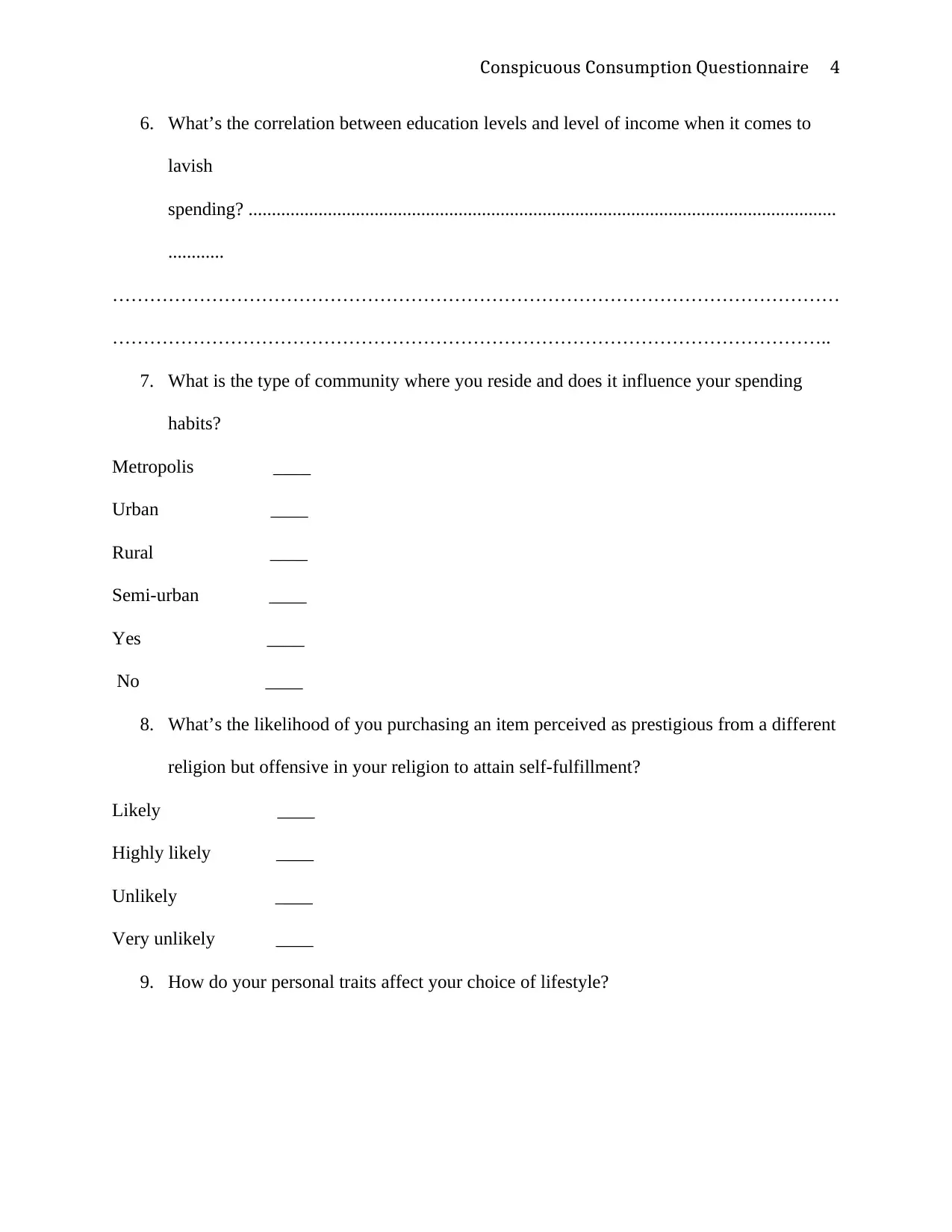
Conspicuous Consumption Questionnaire 4
6. What’s the correlation between education levels and level of income when it comes to
lavish
spending? ..............................................................................................................................
............
………………………………………………………………………………………………………
……………………………………………………………………………………………………..
7. What is the type of community where you reside and does it influence your spending
habits?
Metropolis ____
Urban ____
Rural ____
Semi-urban ____
Yes ____
No ____
8. What’s the likelihood of you purchasing an item perceived as prestigious from a different
religion but offensive in your religion to attain self-fulfillment?
Likely ____
Highly likely ____
Unlikely ____
Very unlikely ____
9. How do your personal traits affect your choice of lifestyle?
6. What’s the correlation between education levels and level of income when it comes to
lavish
spending? ..............................................................................................................................
............
………………………………………………………………………………………………………
……………………………………………………………………………………………………..
7. What is the type of community where you reside and does it influence your spending
habits?
Metropolis ____
Urban ____
Rural ____
Semi-urban ____
Yes ____
No ____
8. What’s the likelihood of you purchasing an item perceived as prestigious from a different
religion but offensive in your religion to attain self-fulfillment?
Likely ____
Highly likely ____
Unlikely ____
Very unlikely ____
9. How do your personal traits affect your choice of lifestyle?
Paraphrase This Document
Need a fresh take? Get an instant paraphrase of this document with our AI Paraphraser
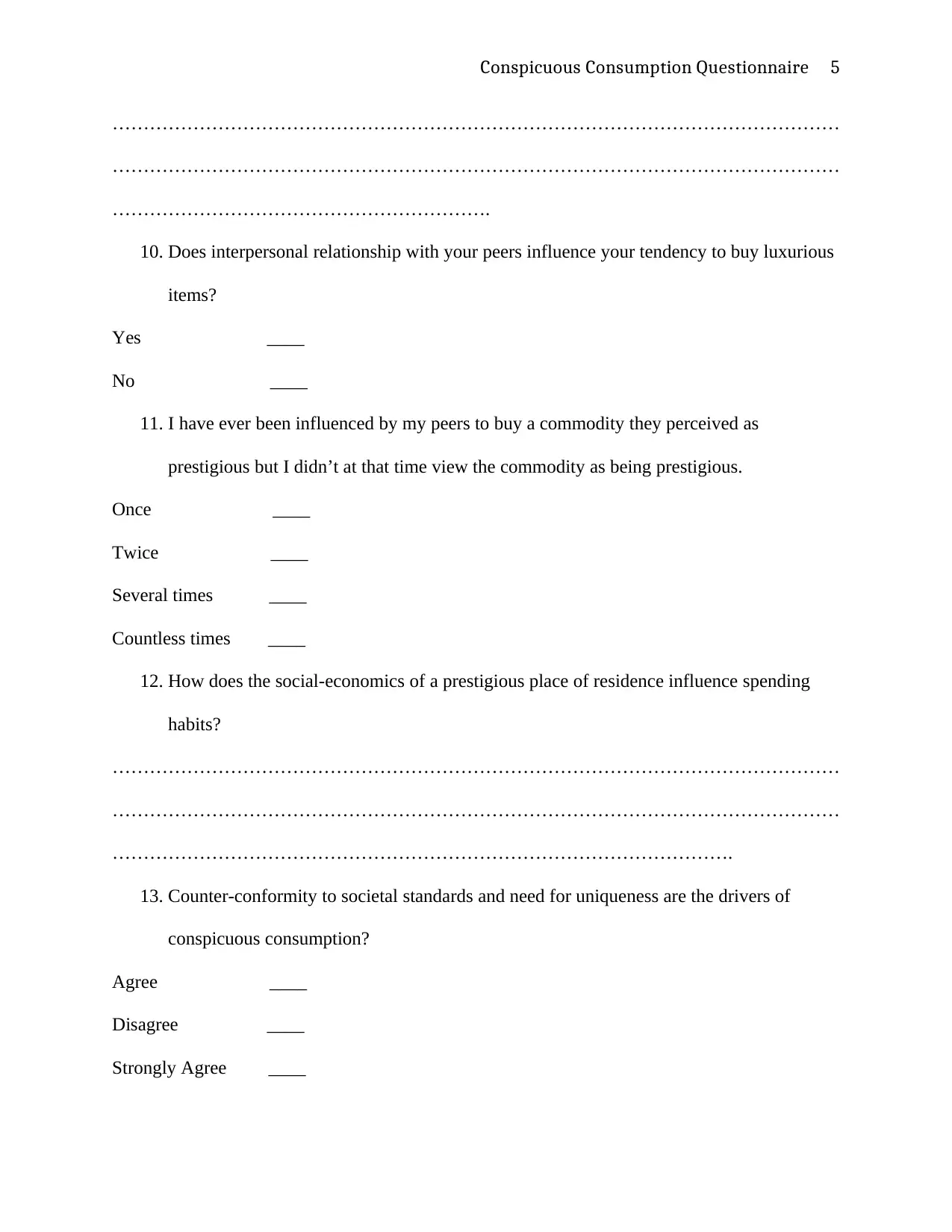
Conspicuous Consumption Questionnaire 5
………………………………………………………………………………………………………
………………………………………………………………………………………………………
…………………………………………………….
10. Does interpersonal relationship with your peers influence your tendency to buy luxurious
items?
Yes ____
No ____
11. I have ever been influenced by my peers to buy a commodity they perceived as
prestigious but I didn’t at that time view the commodity as being prestigious.
Once ____
Twice ____
Several times ____
Countless times ____
12. How does the social-economics of a prestigious place of residence influence spending
habits?
………………………………………………………………………………………………………
………………………………………………………………………………………………………
……………………………………………………………………………………….
13. Counter-conformity to societal standards and need for uniqueness are the drivers of
conspicuous consumption?
Agree ____
Disagree ____
Strongly Agree ____
………………………………………………………………………………………………………
………………………………………………………………………………………………………
…………………………………………………….
10. Does interpersonal relationship with your peers influence your tendency to buy luxurious
items?
Yes ____
No ____
11. I have ever been influenced by my peers to buy a commodity they perceived as
prestigious but I didn’t at that time view the commodity as being prestigious.
Once ____
Twice ____
Several times ____
Countless times ____
12. How does the social-economics of a prestigious place of residence influence spending
habits?
………………………………………………………………………………………………………
………………………………………………………………………………………………………
……………………………………………………………………………………….
13. Counter-conformity to societal standards and need for uniqueness are the drivers of
conspicuous consumption?
Agree ____
Disagree ____
Strongly Agree ____
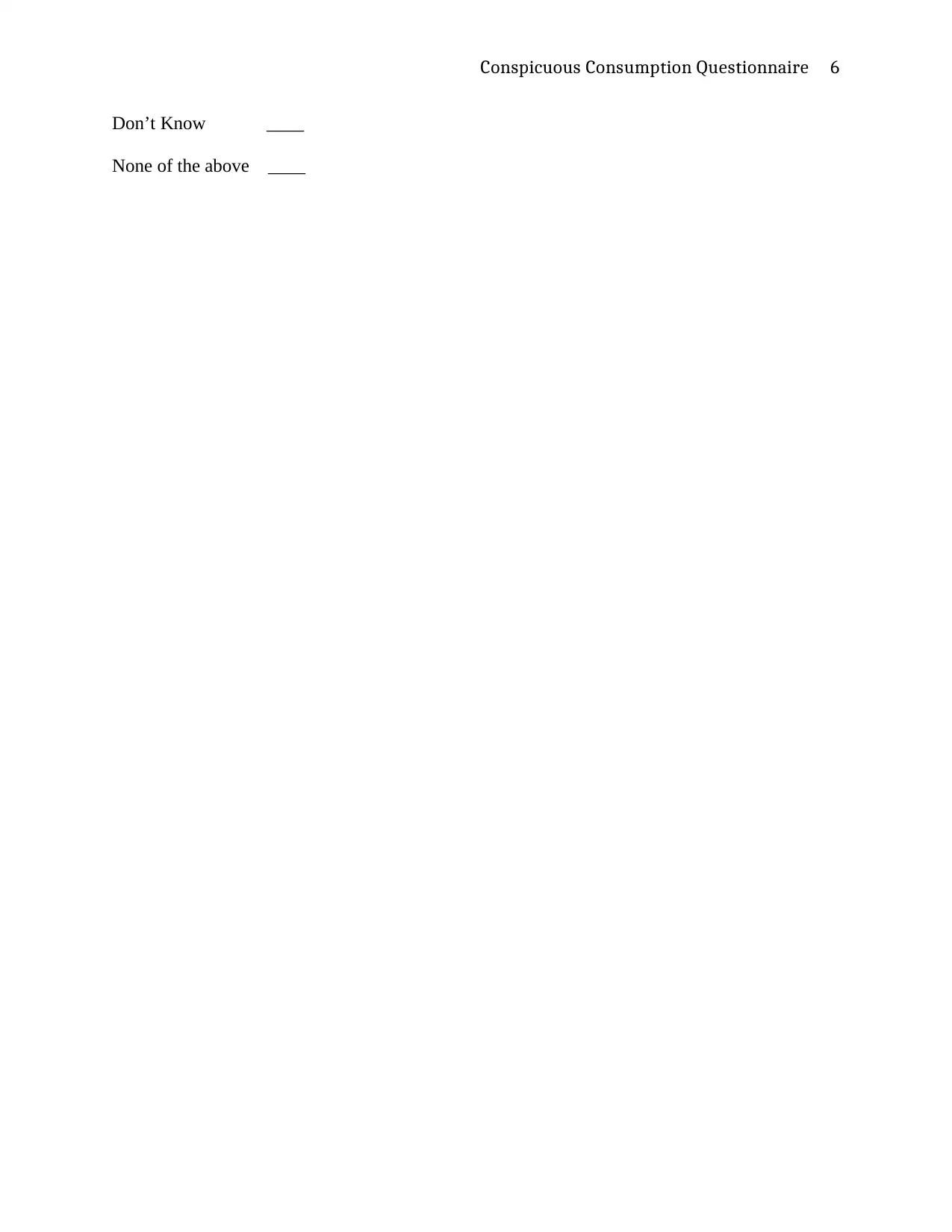
Conspicuous Consumption Questionnaire 6
Don’t Know ____
None of the above ____
Don’t Know ____
None of the above ____
⊘ This is a preview!⊘
Do you want full access?
Subscribe today to unlock all pages.

Trusted by 1+ million students worldwide
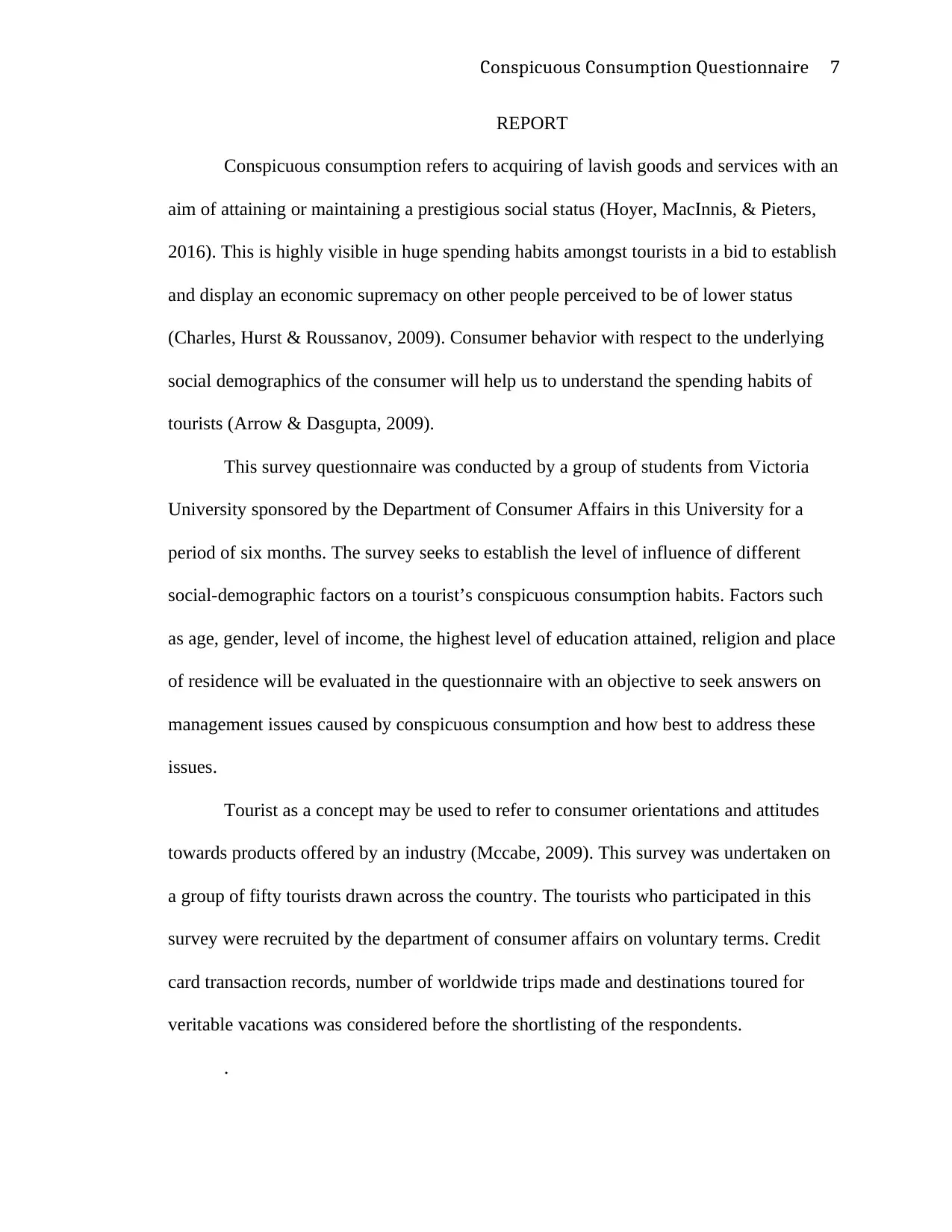
Conspicuous Consumption Questionnaire 7
REPORT
Conspicuous consumption refers to acquiring of lavish goods and services with an
aim of attaining or maintaining a prestigious social status (Hoyer, MacInnis, & Pieters,
2016). This is highly visible in huge spending habits amongst tourists in a bid to establish
and display an economic supremacy on other people perceived to be of lower status
(Charles, Hurst & Roussanov, 2009). Consumer behavior with respect to the underlying
social demographics of the consumer will help us to understand the spending habits of
tourists (Arrow & Dasgupta, 2009).
This survey questionnaire was conducted by a group of students from Victoria
University sponsored by the Department of Consumer Affairs in this University for a
period of six months. The survey seeks to establish the level of influence of different
social-demographic factors on a tourist’s conspicuous consumption habits. Factors such
as age, gender, level of income, the highest level of education attained, religion and place
of residence will be evaluated in the questionnaire with an objective to seek answers on
management issues caused by conspicuous consumption and how best to address these
issues.
Tourist as a concept may be used to refer to consumer orientations and attitudes
towards products offered by an industry (Mccabe, 2009). This survey was undertaken on
a group of fifty tourists drawn across the country. The tourists who participated in this
survey were recruited by the department of consumer affairs on voluntary terms. Credit
card transaction records, number of worldwide trips made and destinations toured for
veritable vacations was considered before the shortlisting of the respondents.
.
REPORT
Conspicuous consumption refers to acquiring of lavish goods and services with an
aim of attaining or maintaining a prestigious social status (Hoyer, MacInnis, & Pieters,
2016). This is highly visible in huge spending habits amongst tourists in a bid to establish
and display an economic supremacy on other people perceived to be of lower status
(Charles, Hurst & Roussanov, 2009). Consumer behavior with respect to the underlying
social demographics of the consumer will help us to understand the spending habits of
tourists (Arrow & Dasgupta, 2009).
This survey questionnaire was conducted by a group of students from Victoria
University sponsored by the Department of Consumer Affairs in this University for a
period of six months. The survey seeks to establish the level of influence of different
social-demographic factors on a tourist’s conspicuous consumption habits. Factors such
as age, gender, level of income, the highest level of education attained, religion and place
of residence will be evaluated in the questionnaire with an objective to seek answers on
management issues caused by conspicuous consumption and how best to address these
issues.
Tourist as a concept may be used to refer to consumer orientations and attitudes
towards products offered by an industry (Mccabe, 2009). This survey was undertaken on
a group of fifty tourists drawn across the country. The tourists who participated in this
survey were recruited by the department of consumer affairs on voluntary terms. Credit
card transaction records, number of worldwide trips made and destinations toured for
veritable vacations was considered before the shortlisting of the respondents.
.
Paraphrase This Document
Need a fresh take? Get an instant paraphrase of this document with our AI Paraphraser

Conspicuous Consumption Questionnaire 8
The group of students administering the survey and the Department of Consumer
affairs at Victoria University held a joint session before the commencement of the survey.
They were informed of the objectives of the survey by the department of consumer affairs
members. The need for data on social demographic factors influencing the future
behavioral intention of tourists was explained to the group. In this joint session, the group
of students was informed of the need to regulate the level of spending on luxury goods
and services amongst tourists.
This survey employed a standardized measurement questionnaire to get feedback
from the respondents. In-person administration technique was used to get data from
respondents (Fowler Jr, 2013). A mixture of open-ended and closed-ended questions was
used in the questionnaire. A single-select multi choice, multiple-select multi choice,
open-ended text responses and scalable responses questionnaire approaches were used to
design the questions for the survey. Ordinal data and interval data was sought from the
respondents through ratable responses. The names and addresses of the respondents to be
used in the questionnaire survey were provided by the department of consumer affairs
(Sarantakos, 2012).
An introductory statement was used in the questionnaire to inform the
respondents who the proponents of the survey were and the objectives of the
questionnaire survey (Abramzon et al, 2014). A set of four factual responses about the
respondent’s personal data were sought after the introductory statement. Thereafter
throughout the survey, a mixture of behavioral and attitudinal questions was used
(Dömyei & Taguchi, 2009).
The group of students administering the survey and the Department of Consumer
affairs at Victoria University held a joint session before the commencement of the survey.
They were informed of the objectives of the survey by the department of consumer affairs
members. The need for data on social demographic factors influencing the future
behavioral intention of tourists was explained to the group. In this joint session, the group
of students was informed of the need to regulate the level of spending on luxury goods
and services amongst tourists.
This survey employed a standardized measurement questionnaire to get feedback
from the respondents. In-person administration technique was used to get data from
respondents (Fowler Jr, 2013). A mixture of open-ended and closed-ended questions was
used in the questionnaire. A single-select multi choice, multiple-select multi choice,
open-ended text responses and scalable responses questionnaire approaches were used to
design the questions for the survey. Ordinal data and interval data was sought from the
respondents through ratable responses. The names and addresses of the respondents to be
used in the questionnaire survey were provided by the department of consumer affairs
(Sarantakos, 2012).
An introductory statement was used in the questionnaire to inform the
respondents who the proponents of the survey were and the objectives of the
questionnaire survey (Abramzon et al, 2014). A set of four factual responses about the
respondent’s personal data were sought after the introductory statement. Thereafter
throughout the survey, a mixture of behavioral and attitudinal questions was used
(Dömyei & Taguchi, 2009).
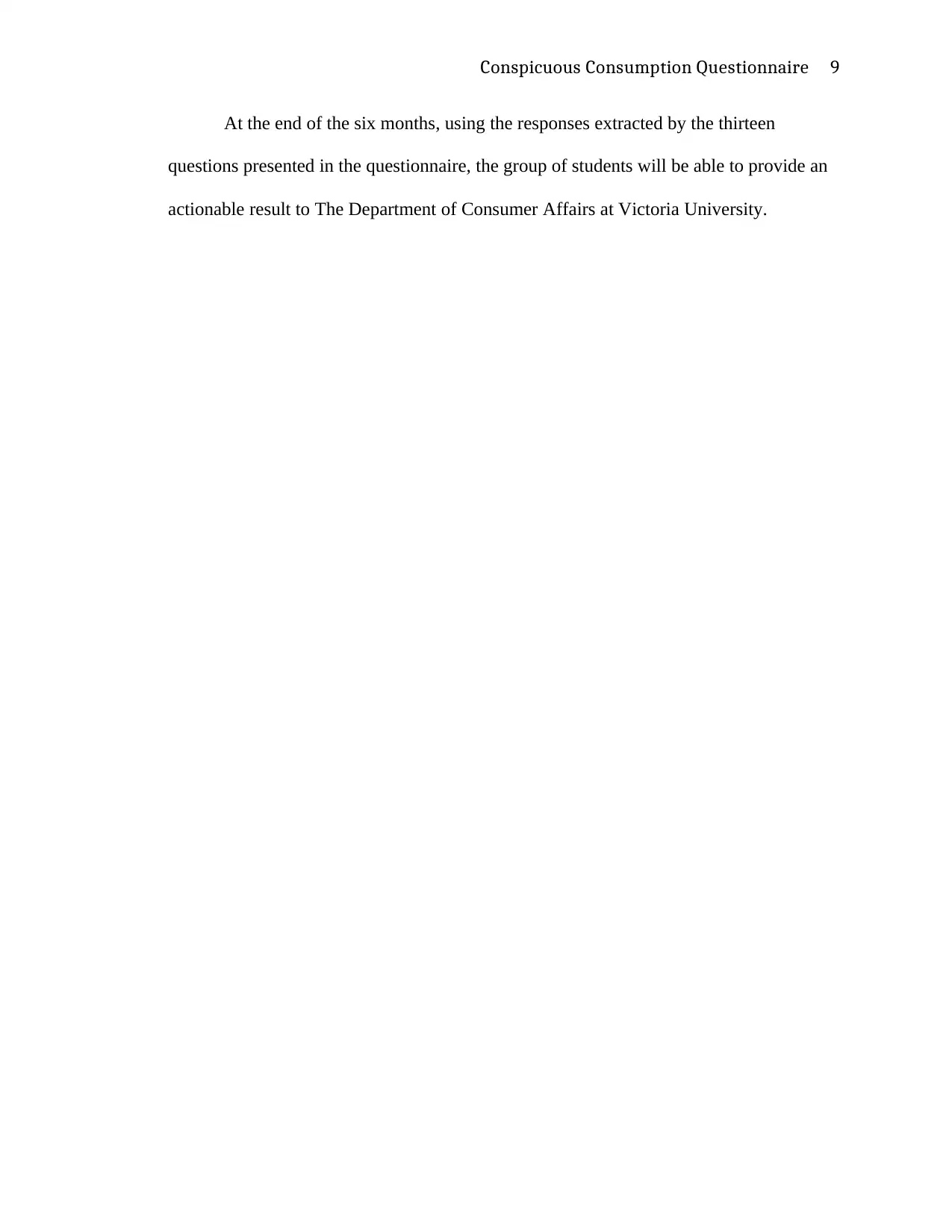
Conspicuous Consumption Questionnaire 9
At the end of the six months, using the responses extracted by the thirteen
questions presented in the questionnaire, the group of students will be able to provide an
actionable result to The Department of Consumer Affairs at Victoria University.
At the end of the six months, using the responses extracted by the thirteen
questions presented in the questionnaire, the group of students will be able to provide an
actionable result to The Department of Consumer Affairs at Victoria University.
⊘ This is a preview!⊘
Do you want full access?
Subscribe today to unlock all pages.

Trusted by 1+ million students worldwide
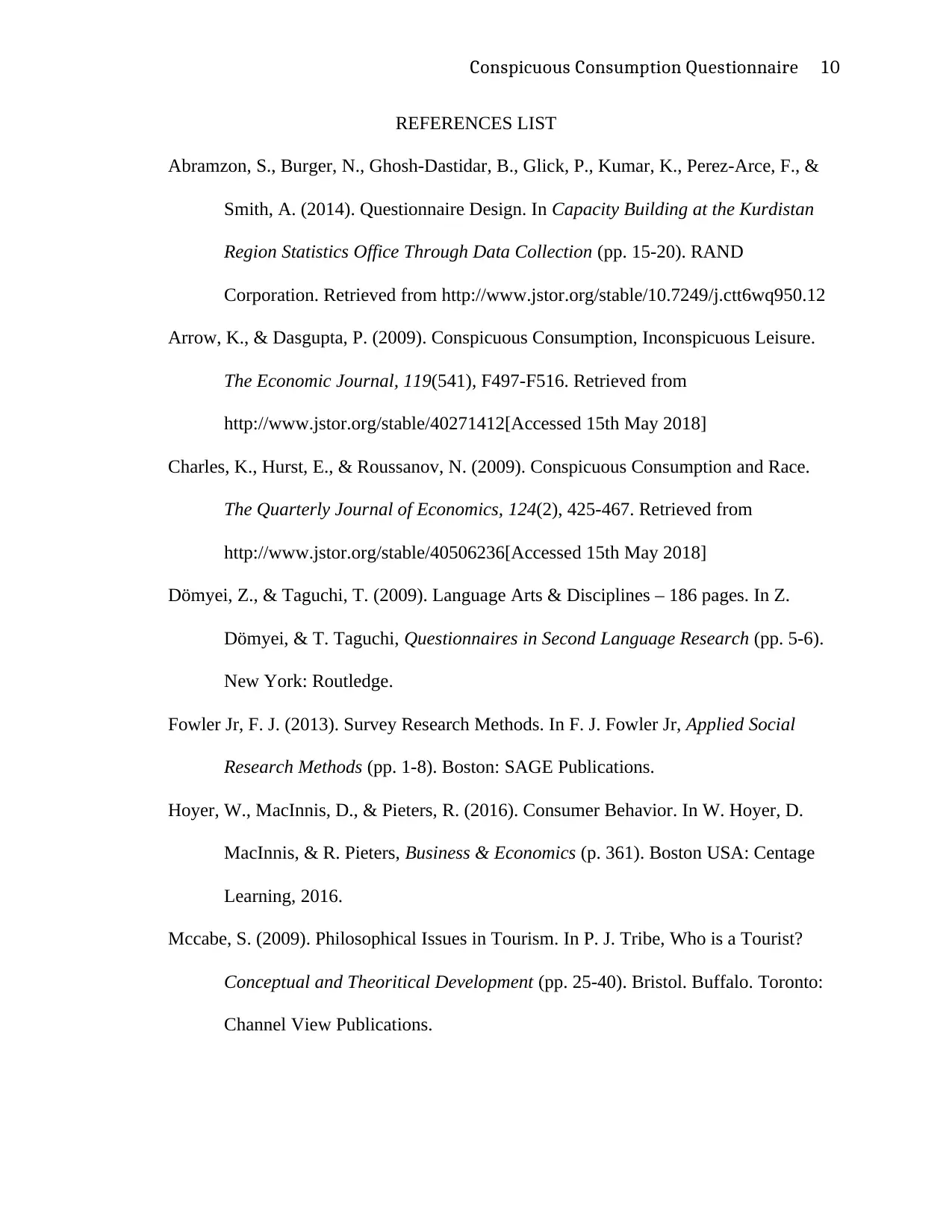
Conspicuous Consumption Questionnaire 10
REFERENCES LIST
Abramzon, S., Burger, N., Ghosh-Dastidar, B., Glick, P., Kumar, K., Perez-Arce, F., &
Smith, A. (2014). Questionnaire Design. In Capacity Building at the Kurdistan
Region Statistics Office Through Data Collection (pp. 15-20). RAND
Corporation. Retrieved from http://www.jstor.org/stable/10.7249/j.ctt6wq950.12
Arrow, K., & Dasgupta, P. (2009). Conspicuous Consumption, Inconspicuous Leisure.
The Economic Journal, 119(541), F497-F516. Retrieved from
http://www.jstor.org/stable/40271412[Accessed 15th May 2018]
Charles, K., Hurst, E., & Roussanov, N. (2009). Conspicuous Consumption and Race.
The Quarterly Journal of Economics, 124(2), 425-467. Retrieved from
http://www.jstor.org/stable/40506236[Accessed 15th May 2018]
Dömyei, Z., & Taguchi, T. (2009). Language Arts & Disciplines – 186 pages. In Z.
Dömyei, & T. Taguchi, Questionnaires in Second Language Research (pp. 5-6).
New York: Routledge.
Fowler Jr, F. J. (2013). Survey Research Methods. In F. J. Fowler Jr, Applied Social
Research Methods (pp. 1-8). Boston: SAGE Publications.
Hoyer, W., MacInnis, D., & Pieters, R. (2016). Consumer Behavior. In W. Hoyer, D.
MacInnis, & R. Pieters, Business & Economics (p. 361). Boston USA: Centage
Learning, 2016.
Mccabe, S. (2009). Philosophical Issues in Tourism. In P. J. Tribe, Who is a Tourist?
Conceptual and Theoritical Development (pp. 25-40). Bristol. Buffalo. Toronto:
Channel View Publications.
REFERENCES LIST
Abramzon, S., Burger, N., Ghosh-Dastidar, B., Glick, P., Kumar, K., Perez-Arce, F., &
Smith, A. (2014). Questionnaire Design. In Capacity Building at the Kurdistan
Region Statistics Office Through Data Collection (pp. 15-20). RAND
Corporation. Retrieved from http://www.jstor.org/stable/10.7249/j.ctt6wq950.12
Arrow, K., & Dasgupta, P. (2009). Conspicuous Consumption, Inconspicuous Leisure.
The Economic Journal, 119(541), F497-F516. Retrieved from
http://www.jstor.org/stable/40271412[Accessed 15th May 2018]
Charles, K., Hurst, E., & Roussanov, N. (2009). Conspicuous Consumption and Race.
The Quarterly Journal of Economics, 124(2), 425-467. Retrieved from
http://www.jstor.org/stable/40506236[Accessed 15th May 2018]
Dömyei, Z., & Taguchi, T. (2009). Language Arts & Disciplines – 186 pages. In Z.
Dömyei, & T. Taguchi, Questionnaires in Second Language Research (pp. 5-6).
New York: Routledge.
Fowler Jr, F. J. (2013). Survey Research Methods. In F. J. Fowler Jr, Applied Social
Research Methods (pp. 1-8). Boston: SAGE Publications.
Hoyer, W., MacInnis, D., & Pieters, R. (2016). Consumer Behavior. In W. Hoyer, D.
MacInnis, & R. Pieters, Business & Economics (p. 361). Boston USA: Centage
Learning, 2016.
Mccabe, S. (2009). Philosophical Issues in Tourism. In P. J. Tribe, Who is a Tourist?
Conceptual and Theoritical Development (pp. 25-40). Bristol. Buffalo. Toronto:
Channel View Publications.
1 out of 10
Related Documents
Your All-in-One AI-Powered Toolkit for Academic Success.
+13062052269
info@desklib.com
Available 24*7 on WhatsApp / Email
![[object Object]](/_next/static/media/star-bottom.7253800d.svg)
Unlock your academic potential
Copyright © 2020–2025 A2Z Services. All Rights Reserved. Developed and managed by ZUCOL.


